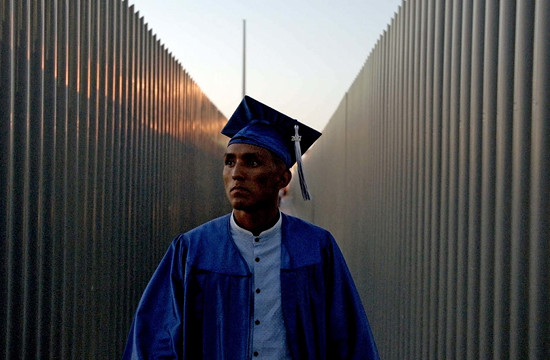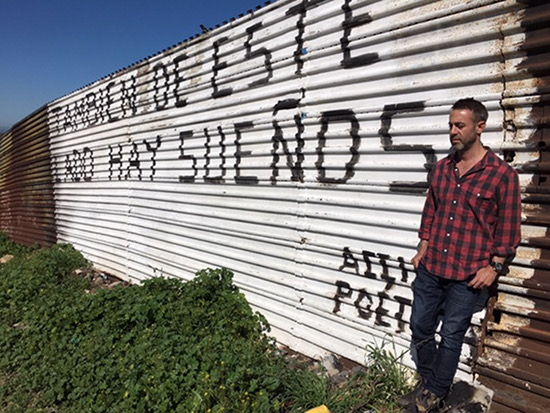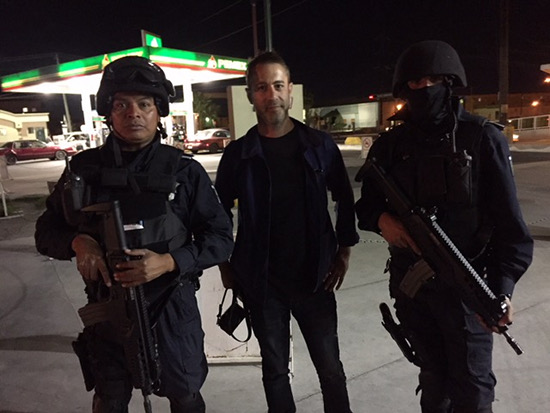
Matt Ogens on Exploring Student Life on the US / Mexican Border in ‘Home + Away’

‘Home + Away’ is a new feature documentary by Bullitt Entertainment and director Matt Ogens. Following the search for the American dream on the extreme edge of the nation, the film explores life at Bowie High School, based in El Paso just a stone’s throw away from the notorious Mexican city of Juarez. But despite the complications between the US / Mexican border, kids risk the travel from Juarez to El Paso everyday in order to attend Bowie. The school itself had long been plagued by corruption but, much like the children that attend, is once more striving for success. Sports plays an integral part in both the students’ lives and ‘Home + Away’. It’s a way of building community, of overcoming adversity and building confidence.
Upon learning of these students’ daily international travel for study - and given the current political landscape in the US and conversations around the border ‘wall’ - director Matt was compelled to make a film about it. It premiered at Tribeca last month and is continuing on the festival trail before official release soon.
LBB’s Addison Capper chatted with Matt to find out more about this remarkable story.
LBB> ‘Home + Away’ premiered at Tribeca Film Festival - how did it feel to see it there and how was it received?
MO> Premiering Home + Away at the Tribeca Film Festival was an amazing experience. I lived in downtown Manhattan on 9/11, not far from the World Trade Center. Tribeca was created as a response, as a way to revitalise business in the area. So to be able to premiere our film here was very personal and special for me. In addition, Tribeca and the audiences at this festival really appreciate documentary filmmaking. Docs are taken very seriously here and it feels like they place as much significance on docs as narrative films. It’s all storytelling. The best part of the experience was bringing the kids in our film up to New York for the premiere. Two of the characters in the film, Erik and Francisco, had never even been on a plane before. This was a life-changing experience for them.
LBB> When did you first learn of the stories of these students who cross the border everyday to attend school? Can you tell us a bit about the situation they’re in?
MO> Ideas and stories come to me in a variety of ways. I like to find personal, intimate, character-driven stories that audiences can go on a journey with, but also speak to larger, relevant themes. In this case, given what was going on politically about immigration and ‘the border’, I was curious what the closest high school in America was to the Mexican border. Through research, we found Bowie High School, located in El Paso, Texas, which sits about 50 yards from the border with Ciudad Juarez. We reached out to the school and learned that a lot of the students have family on both sides and cross regularly to attend school. That’s when I knew there was a story to tell here. Imagine waking up at dawn in another country, walking through Juarez, crossing the border to get an education. Many of these kids come from impoverished backgrounds, their families work so hard to put food on the table, yet you never hear them complain about their lot in life. They are so resilient. They are so strong. To them, this is normal. I think there is a lot to learn from them.

Matt at the border
LBB> And why were you compelled to produce a film about it?
MO> I was particularly drawn to Bowie High School as a paradigm of life on the border. What makes this story stand out are the multiple elements that all come together to create an incredibly layered story mixed with danger, sacrifice, and the search for a better life.
I’m drawn to films about underdogs who are down, but not out. People who have taken hits, but refuse to give up. They represent what’s best in the human spirit. There’s something beautiful and poetic about their will, and these are stories that we hope will resonate and captivate an audience in need of heroes. The reality of their lives sometimes has a brutal rawness that’s unnerving. But interwoven with that is a surprising beauty of hope that will not be denied.
LBB> A huge playing factor here is Trump’s presidency and his wish to build a wall along the border - how did this inform your decision to make this film and your approach to it?
MO> Often in the news, we hear about a topic in a macro sense. A topic is put forth and everyone has an opinion, a knee-jerk reaction. Politicians make decisions, we support one side of a debate. But we rarely get a glimpse into the micro human stories. In this case, immigration and the border. Decisions are being made, opinions are put forth, but no one is checking in with the people affected by these decisions. I was compelled to make this film because I wanted to create empathy, to humanise the border. Let’s check in with the people who are directly impacted by decisions made in Washington. Just putting up a ‘Wall’ is a simple solution for a complex situation.
LBB> A big focal point of the film is how sports is offering the students hope - how early on did that focus come into proceedings? Was it always a big part?
MO> Sports is at the heart of the film – for these kids it’s a way of building community and belonging, learning to overcome adversity, and build self-respect and confidence. Bowie High’s sports programs don’t have the resources of other schools – kids and coaches struggle to make ends meet, even paying out of pocket for equipment. Sports anchors the film, it’s both a core theme and a narrative through-line. It’s a way of visualising the kids’ challenges and victories in an active, dynamic way. A way of bringing to life their spirit, their efforts to overcome the challenges they face – as the border’s many challenges threaten to disrupt this community.
There’s a pride in this school, a pride in their heritage and a sense of legacy as many of the students have parents and grandparents that went to Bowie. It’s a part of their culture. However, as much pride as there is, it doesn’t change that this is a school struggling to provide for its students — especially in athletics. There is virtually no money for sports programs. To give a sense of how severe the budget cuts have been, the wrestling team used the money from recycled cardboard returns to buy wrestling shoes. Bowie High School students want to compete athletically at the top level. They have the will, they have the passion, and coaches willing to sacrifice everything to help the kids reach their goal. But they’re always scrambling for the most basic equipment. All they want is an equal playing field against their opponents.

LBB> You must have spent periods of time on both sides of the border, meeting families of the students. Are there any particular moments or stories that have stayed with you? Why so?
MO> So many stories and people, but there is only so much you can fit into one film. In the end, I felt Shyanne, Erik, and Francisco not only had compelling lives unfolding in real time, but in a way they are avatars for all the kids living on the border. Each of the kids in our film had a different relationship with the border I wanted to explore.
Roughly 1/4 of the kids who attend Bowie travel from Juarez, Mexico to El Paso in the pursuit of the American dream. There’s a remarkable dichotomy between the two sides. While the area Bowie High School is located in is very poor, El Paso is also very safe. Whereas in Juarez, there’s always danger lurking outside their doors – the diversity of the two settings make for characters themselves in our story.
The threat of Juarez violence hangs over the kids who have family there. Every time they go back to Juarez, there’s fear about what could happen. Most have been touched by the drug wars in one way or another. But they also see that life doesn’t have to be that way, it’s why they face that fear, waking up at 5am to brave the journey across the border. They legally cross through border patrol. Some of these kids have had family members killed. Two students were shot and killed several years ago. Just last year, only 50 yards from the field – yes, that’s how close the school is to Juarez – a Juarez cop was ambushed and killed within sight of the kids who were practicing.
LBB> Personally, how has making this film affected you?
MO> The heroes in this film show incredible courage and determination to triumph over adversities many of us couldn’t otherwise imagine. These are stories about kids, their parents – and entire communities – fighting to find and hold onto the American Dream. In an age where there’s so much to be depressed and divided about in the Red vs. Blue battles, these stories bring people together. They’re filled with heart and pain, loss, and redemption – and they reflect what’s best in all of us. They give people something to believe in again.
LBB> More broadly, how does this film fit in to your directing career and compare to other things you've worked on, both commercially and artistically?
MO> I’m drawn to people and stories that I’m curious about. I hope that if I’m curious about a topic, then perhaps an audience will also connect with it. I look for stories where, as a filmmaker, I don’t know all the answers, where I can learn something about humanity and share it with others. I like to tell human stories, whether that be through a film or through branded content and commercials, or immersive storytelling like AR and VR. The format may be different, the mechanism through which an audience experiences content may be different, but underneath it’s still about character and story.
LBB> Overall, what will you remember most about the process of making this film?
MO> The kids, their families, Bowie High School, and the communities in El Paso and Juarez.













